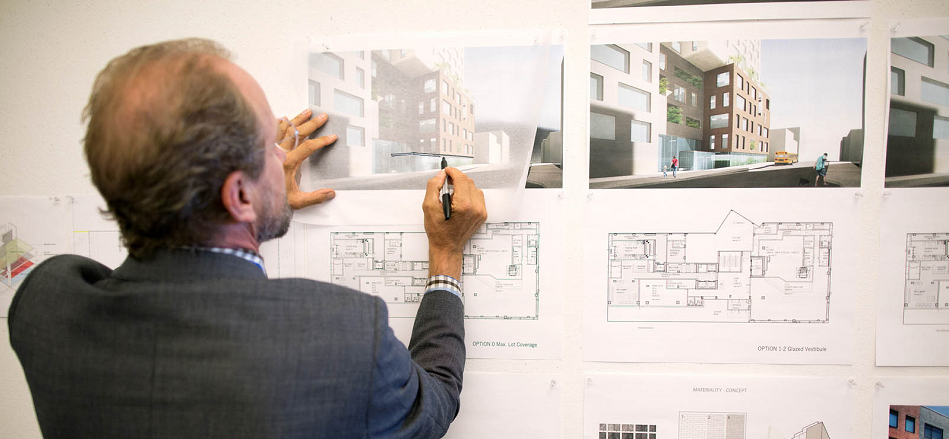Tag archives for: hiring an architect

In our third installment of Archinect’s Guide to Job Titles series, we attempt to tackle the nuanced role of the Studio Director without falling back on search engines like Google and Bing or job boards like Glassdoor, Indeed, Monster, or Ladders [not in original article]. As with most positions within architecture firms, the lines are quite blurry when it comes to the role of Studio Director. For some, this leadership position acts as a kind of operations specialist and strategist while also functioning as a firmwide design leader. For others, the Studio Director might function as a buffer between design teams and the higher-level leadership of an organization. And for others still, this individual might run their studio as a kind of “mini-firm” within a larger firm, responsible for their own business development, hiring, project management, and overall growth. The intricacies and variations associated with such a dynamic posting can’t be explained exhaustively, there will always be some deviation. Nevertheless, what follows is our attempt to capture the inherent essence of this career path in architecture.
Structural Relevance
Architecture firms come in many forms. Depending on size, the internal structure of the personnel will differ. Some firms might operate in a departmental structure, where each team works on a specific phase of a project: a design “department” might work on the programming and schematic phases before passing the work on to a technical department that would realize the construction documentation. Others might have various project teams, each with its own project managers who are overseen by a Studio Director or Principal(s). And others still might divide into multiple studios, each with a specific function, and led by their own Studio Director, respectively. In this structure, each Studio Director would report to a Managing Principal, Design Principal, or both. Some Studio Directors may even be partners of the firm or Principals themselves. When it comes to the possible organizational structures of design firms, the variations are many.
While the interpretation of the role will differ from office to office, a Studio Director will typically oversee a studio. This may be a single studio under one roof, with a small or medium-sized staff, separated into smaller teams, each with a project architect/project manager, a job captain, and designers. Each team leader could report to a Studio Director who then might report to or collaborate with a higher-level leadership team, such as a firm’s Principal(s).
A studio could also be one of many within a larger firm, each with an expertise focus such as hospitality, healthcare, sports, workplace, restoration, or interiors. Each Studio Director would have specialized knowledge and experience in their area of expertise. In this model, studios might operate under the umbrella of a larger firm but would function as its own “sub-firm,” having its own clients, staff, and sometimes even its own receptionist. These “studio structures” can vary widely, and the nuances will depend on the organization in question.
A Studio Director Needs to be a People Person
In Archinect’s Growing Leadership and Practice: Laney LA’s Search for a Studio Director, we dove deep into conversation with Anthony Laney of Laney LA about his search for a Studio Director. “On day one, five project managers, each with their own team of one to two aspiring architects, will report to the Studio Director,” Laney told Archinect. “So, in total, the Studio Director will be leading a team of about 14 people. Right now, I’m giving about 30 percent of my time to a Studio Director role. We want to tear the lid off of that and allow someone to give it 100 percent of their time.” Here we have the leader of a relatively medium-sized firm in need of a Studio Director to act as a point person between him and his project managers. Laney saw this as someone who was not only in love with design, but who also had a deep passion for creating and building a great team.
People skills are 80 percent of the job, probably more…
Archinect also spoke with Lindsay Green, Principal and Studio Director at OFFICEUNTITLED, and Shawn Gehle, Principal and Co-Founder. On the topic of managing a team and dealing with different kinds of people, the pair elaborated further. “People skills are 80 percent of the job, probably more,” they said. “You have to deal with multiple personalities every day. Happy people; sad people; staff; clients; personal issues amongst the team.” They went on to articulate the expansive role a Studio Director might have within an office. In addition to effectively managing people, a leader in this role might also take on responsibilities of reviewing the office’s backlog and ensuring future staffing needs are fulfilled, overall professional development and client management, internal development of team members, human resources, and finance. “We really rely on Lindsay to run this office, we look to her to understand our overall health and outlook,” Gehle said of Green. “She acts as a kind of Chief Operations Officer, shepherding the resources within the office.”
A Strong Business Acumen
Green’s role goes far beyond that of the traditional project manager or project architect, but rises further into rigorous strategic planning and execution, calling for business acumen and facility not typical in architects. “I think if someone is considering this role as something to work towards in their career, they should consider getting an MBA. Understanding business is crucial in this position,” Green elaborated. “And even after that, it’ll take on-the-job experience to establish an understanding of how firms operate.”
Where before one’s core preoccupation might have been client satisfaction, design quality, timely deliverables, and internal team health, the focus now expands to a broader higher level concentration dealing with the business, strategic, and developmental aspects of the organization as a whole. Yes, project teams are concerned with these aspects, but on a fundamentally different level. They have a responsibility for their projects, whereas a Studio Director’s daily duties directly deal with the trajectory and direction of the bigger picture, moving beyond a partial focus to a comprehensive one.
What are firms looking for?
So what are firms looking for in a Studio Director? Take Gensler, a corporation based around a “collaborative studio leadership model.” Each studio has a specialty and is led by a highly experienced Studio Director, who oversees everything from overall management of the team and projects to the finances and budget. They work closely with staff in both professional development and mentorship as well as hiring in collaboration with HR. Studio Directors at Gensler are responsible for marketing, developing new business, and responding to RFPs, along with several other high-level responsibilities. According to Gensler, those pursuing this role should have a minimum of 15 years of experience and have a proven record in their area of focus. Moreover, Studio Directors at Gensler should possess a comprehensive personal portfolio of work, illustrating their aptitude and understanding of their expertise. Essentially, Studio Directors are leaders of their own small firm within the larger organization that is Gensler.
A Multi-Disciplined Leader
In the end, Studio Directors are multi-disciplined leaders with a depth of experience that allows them to lead a team of professionals of varying experience levels. They operate on multiple fronts, some of which include business functions such as staff development, hiring, strategic planning, finances, as well as traditional functions like QAQC, guiding design quality, and managing clients and projects. The possibilities appear broad and wide-ranging, but we’ve learned that business acumen is crucial, people skills are essential, and a deep understanding of the traditional functions of the architect, indispensable.
Author – Sean Joyner is an architect-trained writer and editor at Archinect. His articles and essays utilize themes in history, philosophy, and psychology to explore lessons for students and professionals within the fields of architecture and design. Sean’s work prior to Archinect focused primarily on k-12 and higher education projects in Southern California. Some of the things Sean enjoys are playing and practicing chess, studying obscure topics like quantum physics and cryptography, working out, and reading compelling books.
Sean Joyner’s Blog on Archinect
Archinect
Consulting For Architects, Inc. Staffing and Recruiting Hiring Trends Blog
Articles:
Salary and responsibilities for design directors for interior design
Harvard GSD announces winners of 2020 Richard Rogers Fellowship
Job Titles
|
Archinect, architecture, architecture jobs, Careers, Consulting For Architects, design, Gensler, Hiring, hiring an architect, hiring firms, ilookup, jobs, mentoring, studio, studio director, teaching, titles
|

When I read an article titled “People are ‘ghosting’ at work, and it’s driving companies crazy” by Chip Cutter, LinkedIn Editor at Large, I flipped out because it is so true and it should be an eye-opener to hiring firms. I have added my own pointers as well.
Gone are the days where architects are waiting around for a phone call from a potential employer. In fact, it is the opposite. Candidates receive two, sometimes three offers of employment in a week’s time.
Excerpts from Chip’s article below:
Where once it was companies ignoring job applicants or snubbing candidates after interviews, the world has flipped. Candidates agree to job interviews and fail to show up, never saying more. Some accept jobs, only to not appear for the first day of work, no reason given, of course. Instead of formally quitting, enduring a potentially awkward conversation with a manager, some employees leave and never return. Bosses realize they’ve quit only after a series of unsuccessful attempts to reach them. The hiring process begins anew.
Among younger generations, ghosting has “almost become a new vocabulary” in which “no response is a response,” says Amanda Bradford, CEO and founder of The League, a dating app. Now, “that same behavior is happening in the job market,” says Bradford, who’s experienced it with engineering [architecture and design] candidates who ghosted her company.
Some of the behavior may stem not from malice, but inexperience. Professionals who entered the workforce a decade ago, during the height of the Great Recession, have never encountered a job market this strong. The unemployment rate is at an 18-year low. More open jobs exist than unemployed workers, the first time that’s happened since the Labor Dept. began keeping such records in 2000. The rate of professionals quitting their jobs hit a record level in March; among those who left their companies, almost two thirds voluntarily quit. Presented with multiple opportunities, professionals face a task some have rarely practiced: saying no to jobs.
“Candidates are winding up with multiple offers, and you can’t accept them all,” says Dawn Fay, district president at Robert Half International in New York. “Individuals just inherently don’t like conflict or disappointing people.”
Thus, ghosts. Interviews with more than a dozen hiring managers and recruiters across the U.S. suggest the practice is on the rise, forcing companies to rethink how they operate. END.
Top 6 changes hiring firms must make to compete for top talent:
1. Everyone wants Revit proficiency. Guess what; there is a major shortage. If the candidate meets most of your other requirements, then, intensive on-the-job Revit training is needed. Particularly, if they have AutoCAD or ArchiCAD skills.
2. If you believe the candidate has 85-90% of the skillset your job description requires, grab that candidate and don’t look back! How many people are currently employed at your firm that did not have all the skills they have now? Play the long game.
3. Do not prolong the process from receiving the resume, scheduling an interview and making an offer. Or else, a competitor will scoop the candidates right out from under you.
4. Cut down on the long hours. The trend has been Work/Life Balance, and it starts with more personal time. If you had a choice, would you pick a firm with a 60-hour work week or 40-hour work week. Not only do your employees burn out, their salaries are totally diluted.
5. The main motivators in switching firms are better compensation, growth potential, better corporate fit, recognition of skillset, better management and more interesting projects.
6. If you are designing single-family homes and the candidate has an array of educational projects, the tendency is to reject the candidate out of hand. But, the less flexible you are, the smaller the talent pool becomes. Why not give the candidate a chance? Mentor h/her; a good architect can learn new building types. And besides, architects do not want to be pigeon-holed. They want new career opportunities. And besides architects do not want to be pigeon-holed. They want new career opportunities.
Not made these fundamental changes? Then you are losing top talent to your competitors.

Video Interviews
Top 5 Reasons to try video interviews?
1. Reduces your carbon footprint.
2. Reduces traveling to multiple interviews.
3. Embraces new innovations and technologies.
4. Presents you as a person, not a piece of paper.
5. Employers (9 out of 10) watch video resumes before reading paper resumes. Clients frequently submit their own questions for you.
The benefits of embracing video interviews for the environment are easy to see, but it’s also great at cutting down wasted time in your career search. Think of how tough it can be to schedule interviews at the best firms. Now imagine how easy it could be if the firm could meet you virtually from anywhere, at any time. Best of all, the environment gets a reprieve.
Video Interviews Help Staffing Firms Become More Successful
Staffing firms are a collection of professional Talent Acquisition professionals. But their lives could be made so much easier with video interviews. Many staffing firms employ Talent Acquisition specialists who often find they lack enough time in the day to complete every task, or who become exasperated trying to track candidates down. Using video interviews, staffing firms can help their Talent Acquisition team get their lives back. Find out how:
• Video interviews save staffing firms time. When it comes to finding the right candidate, it’s up to their Talent Acquisition team to source and screen hundreds of candidates for just the right fit. Often, this is done by building talent pools from which to read through matching resumes. Then comes the old phone screen. This can be a cumbersome process. A phone screen could take an hour per employee. However, many staffing firms are increasingly finding that by using video interviews, they’re able to screen more candidates in less time. Imagine the Talent Acquisition pros being able to sit back and collect video interviews on demand from candidates. This means less time trying to track candidates down and schedule formal phone screens. Instead, they can send an email with a link that candidates log onto to prepare their video on demand. Suddenly, staffing firms are able to put the onus on candidates. They can simply sit back and wait for a candidate to record their video interview on demand and send it to the Talent Acquisition professional. Staffing firms, are able to view 10 video interviews on demand in the span of time it takes to do one phone screen.
• Collaboration is enhanced with video interviews. Often, the Talent Acquisition pros in staffing firms feel as if they’re operating in a bit of a vacuum. We’ve heard from many staffing industry pros that they find a great candidate they’d like to share, but it can be difficult to break through the noise of candidate resumes flowing in and collaborate. This can be a frustration of the past. With video interviews, staffing firms are able to view, score and share the top video interviews with their colleagues. This brings more eyes into the process and ensures a better candidate screening overall.
• Video interviews enhance the candidate experience. Of the thousands of candidates we work with per month, we hear a common frustration: their candidate experience is lacking. When candidates apply to jobs through staffing firms, they can feel like little more than a number. Video interviews can help make them feel like they’re going through a personal experience. Live video interviews are a great way for candidates to log on, view welcome videos, and to gain more information on the position they’re applying for. This allows Talent Acquisition to offer more nuance to the candidate. And using the visual medium, it allows them to tell their client’s story better. Candidates love video interviews because they feel it’s more intimate than walking in and finding 10 other candidates also competing for the same position. Video interviews are technologically advanced and offer candidates an immersive experience, allowing both Talent Acquisition and candidates to tell their story better.
- Time to hire shrinks with video interviews. These days, candidates want a shorter time to hire. According to the Bureau of Labor Statistics, time to hire rose from 24.5 days to 29 days in July of 2015. This is due in part to rising hiring quotas and shrinking budgets to actually accomplish increased hiring requirements. As the Baby Boomer generation begins to retire and employers increasingly look to the Millennial generation to fill these roles, time to hire will become increasingly important. Approximately 33% of Millennials report that they get hired within a month’s time. Longer times to hire could potentially scare away the very best candidates.Staffing firms are finding themselves increasingly in demand because of the roaring return of the economy. As more jobs are added to the job market, their Talent Acquisition teams will find themselves struggling to keep up. With video interviews, they can remain ahead of the curve and deliver superior results to their customers. Interested in finding out more? Call us today and schedule a free demo of our video interview software.
The Job Hunt
|
architects, architecture, business, Candidates, Employment, Freelancers, hiring an architect, Job Interviews, jobs, Resumes, unemployed architects, Video Interview
|

First… Why hire an Architect?
Why Does The AIA Say You Should Hire An Architect?
What do Architects do? And how can they help you?
Why hire an Architect? Few people realize how complicated it is to build-that is until they find themselves lost in a maze of design options, building codes, zoning laws, contractors and so on. No two building projects are exactly alike, so there is no single clear-cut path to follow. Whether you’re about to expand your current facility, adapt an existing structure to a new use, or construct an entirely new building, your building project represents a major investment that will affect the productivity and efficiency of your organization for years. Smart decision-makers know that the way to maximize such an investment begins with consulting an architect. Architects are the only professionals who have the education, training, experience and vision to maximize your construction dollar and ease the entire design and construction process.
Early involvement is key. By helping you define the building project, architects can provide meaningful guidance for design. They can conduct site studies, help secure planning and zoning approvals, and perform a variety of other pre-design tasks. Plus, when architects are involved at the earliest planning stage, they gain more opportunities to understand your business, develop creative solutions, and propose ways to reduce costs. The long-term result is a facility that adds to the productivity, efficiency, and effectiveness of your operation.
(Why hire an architect? Speak with an architect who is a member of The American Institute of Architects (AIA) at the earliest stage of your planning process).
Second. And the reason you are here in the first place…
What are the Top 5 Reasons to Fire Your #Architect?
Q. Are you an architect? Have you ever hired an Architect?
Why Hire an Architect
|
American Institute of Architects, architects, builders, CFA, Consulting For Architects, contractors, David McFadden, do not hire an architect, do you need to hire an architect, hiring an architect, jobs, jobs for architects, recession's affect on architecture, reddit, staffing, Staffing for Architects, unemployed architects
|











